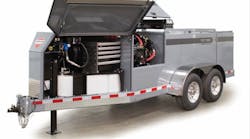The NTEA Truck Equipment Technical Fundamentals Course is designed for truck equipment personnel and others looking to learn industry fundamentals. Industry consultant Richard Toner, and Louie Kleinstiver, NTEA director of technical services, head up the ongoing two-day course. Trailer/Body Builders will provide and overview of the course material in serialized form as the Back-to-Basics Series.
IF YOU BUILD or modify trucks by installing truck bodies, or related equipment, you must certify them. Failure to certify can result in penalties of $1,100 for each violation up to a maximum of $880,000 for a related series of violations.
To certify a vehicle is to document in writing that the vehicle that you helped to produce still conforms to all applicable motor vehicle safety standards. Companies must make such a statement when they install truck bodies or equipment on incomplete vehicles (such as a truck chassis) or if they alter a completed truck that previously had been certified (such as installing a snowplow or replacing a pickup box with a truck body). This process involves:
*Determining vehicle type (chassis cab, bare chassis, cutaway van, or chassis cowl) and the standards that apply to the model being certified.
*Determining the type of conformity statement to be used (there are three, reviewed later in this article),
*Performing a Federal Motor Vehicle Safety Standards (FMVSS) compliance analysis. This is a checklist of the various vehicle components and how they conform to all FMVSS.
*Performing a payload analysis. Payload capacity is determined by subtracting the completed weight of the vehicle, including driver and passengers, from the gross vehicle weight rating (GVWR).
*Performing a weight distribution analysis. This determines the distribution of the total gross vehicle weight imposed on the ground at each axle (measured in units of weight or as a percent of total truck weight).
Anyone who manufactures or assembles motor vehicles or motor vehicle equipment for resale is required to certify, according to Louie Kleinstiver, the National Truck Equipment Association (NTEA) director of technical services.
Who is a Manufacturer?
A manufacturer can be any person who performs a manufacturing operation on a new, incomplete vehicle. This definition includes the manufacturer of the vehicle in its incomplete, intermediate and/or final-stages. Any person who alters a completed vehicle, which has already been certified in the final stage before it is sold, is also considered a manufacturer of motor vehicles under the National Traffic and Motor Vehicle Safety Act and National Highway Traffic Safety Administration (NHTSA) regulations.
All vehicles must be certified in the final stage. Certification is also a requirement for manufacturing operations performed on motor vehicles prior to the first purchase. For example, installing a service body, or removing a pickup box before the vehicle is sold requires certification. After the vehicle is certified in the final stage, and purchased, licensed, and titled, the certification obligation ends.
The four types of motor vehicle certification are incomplete vehicle (chassis cab, stripped chassis, cutaway, cowl); intermediate stage certification; final stage certification (the last maintenance operation before it is put into use); and altered certification (altering a previously certified vehicle). For example, adding a snowplow to a pickup truck requires altered certification.
The incomplete vehicle document is a vital guide to the certification process. The manufacturer must include this document with every new incomplete vehicle. This document helps subsequent manufacturers determine what can or cannot be done to the incomplete vehicle in order to stay within the original manufacturers' guidelines.
The incomplete vehicle document contains the name and address of the incomplete vehicle manufacturer, the month and date of the last manufacturing operation, vehicle identification number, GVWR, gross axle weight rating, and vehicle type, such as truck or multipurpose passenger vehicle. The document also lists the standards (in effect at the time the incomplete vehicle was manufactured) that apply to each type, followed by a conformity statement. The three types of conformity statements are:
Type I: "A statement that the vehicle when completed will conform to the standard if no alterations are made in the identified components of the incomplete vehicle."
Type II: "A statement of specific conditions of final manufacture under which the manufacturer specified that the completed vehicle will conform to the standards."
Type III: "A statement that the conformity with the standard is not substantially affected by the design of the incomplete vehicle, and that the incomplete vehicle manufacturer makes no representation as to conformity with the standard."
Analyzing Payload
A payload analysis is vital because the distribution of chassis, body, and payload weight on a truck is critical to the proper operation and long life of the vehicle. It is possible for a vehicle to be overloaded even though it may not be loaded beyond the recommended GVWR. When a chassis/body combination is incorrectly matched or when the payload is not positioned properly, the front or rear gross axle weight rating (GAWR) may be overloaded.
Once the chassis configuration and payload capacity have been determined, a weight distribution calculation should be performed. This will verify that the weight of the body and/or payload is distributed to both the front and rear axles in proper proportions. It also assures that the front and rear GAWRs are not exceeded.
The weight of the driver and passenger(s) can sometimes make the difference between exceeding and not exceeding a vehicle's GAWR. Therefore, the weight of the driver and passenger(s) is included in the calculations when performing a weight distribution or payload analysis.
Ultimate Responsibility
The final stage manufacturer is the last line of defense for motor vehicle safety and bears full responsibility for any vehicle defects. If there is a defect or non-conformity in the original equipment produced by another manufacturer who refuses to recall the vehicle, the final stage manufacturer is still responsible for recalling the vehicle and correcting the problem.
Once certification is complete, the certification label can be attached to the hinge pillar, the door-latch post, or the door edge that meets the door-latch post. It can also be placed next to the driver's seating position, to the left side of the instrument panel, or the inward facing surface of the door next to the driver's seating position.
Certification labels are available from NTEA. New NTEA certification labels are narrower than the previous version, allowing them to fit on doorjambs. The color-coded labels come with instructions and are tamper-resistant. They are void if removed.
NHTSA requires vehicle manufacturers to retain at least one complete copy of all records pertaining to motor vehicle malfunctions for at least five years. Copies of certification labels affixed to vehicles should also be retained.
For information on ordering the certification guide and vehicle certification labels call the NTEA at 1-800-866-NTEA.








